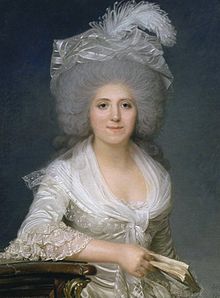- Jeanne-Louise-Henriette Campan
-
Jeanne-Louise-Henriette Campan, born Henriette Genet (6 October[1] 1752, Paris - 16 March 1822, Mantes) was a French educator and lady-in-waiting to Queen Marie Antoinette before and during the French Revolution.
Her father, whose name was Genest, was first clerk in the foreign office, and, although without fortune, placed her in the most cultivated society. At the age of fifteen she could speak English and Italian, and had gained so high a reputation for her accomplishments as to be appointed reader to the three daughters of Louis XV in 1768, and lady in waiting to Marie Antionette in 1770. At court she was a general favorite, and when she in 1774 bestowed her hand upon M. Campan, son of the secretary of the royal cabinet, the king gave her an annuity of 5000 livres as dowry. The marriage was unhappy and the couple separated in 1790. She was appointed first lady of the bedchamber by Marie Antoinette in 1786; and she continued to be her attendant until she was forcibly separated from her at the storming of the Tuileries on 10 August 1792. Her own house was attacked on this occasion, and she sought refuge in the country side.
Jeanne Campan survived the dangers of the Terror, but after the 9th of Thermidor finding herself almost penniless, and being thrown on her own resources by the illness of her spouse, she determined to support herself by establishing a school at St Germain. The institution prospered, and was patronized by Hortense de Beauharnais, whose influence lead to the appointment of Madame Campan as superintendent of the academy founded by Napoleon at Écouen for the education of the daughters and sisters of members of the Legion of Honor in 1807. This post she held until it was abolished at the restoration of the Bourbons in 1814, when she retired to Mantes, where she spent the rest of her life amid the kind attentions of affectionate friends, but saddened by the loss of her only son, and by the calumnies circulated on account of her connexion with the Bonapartes.
She died in 1822, leaving valuable Mémoires sur la vie privée de Marie Antoinette, suivis de souvenirs et anecdotes historiques sur les règnes de Louis XIV.-XV. (Paris, 1823); a treatise De l'Education des Femmes; and one or two small didactic works, written in a clear and natural style. The most noteworthy thing in her educational system, and that which especially recommended it to Napoleon, was the place given to domestic economy in the education of girls. At Écouen the pupils underwent a complete training in all branches of housework.
References
- ^ Madame Campan, Memoirs of the Court of Marie Antoinette, Queen of France, Gutenberg Project, retrieved 6-10-10
 This article incorporates text from a publication now in the public domain: Chisholm, Hugh, ed (1911). Encyclopædia Britannica (11th ed.). Cambridge University Press. The 1911 Britannica article, in turn, gives as its references Les Memoires de Madame de Campan (Paris, 1886), and histories of the time.
This article incorporates text from a publication now in the public domain: Chisholm, Hugh, ed (1911). Encyclopædia Britannica (11th ed.). Cambridge University Press. The 1911 Britannica article, in turn, gives as its references Les Memoires de Madame de Campan (Paris, 1886), and histories of the time.
External links
- Memoirs Of Marie Antoinette at Gutenberg
- Works by Jeanne Louise Henriette Campan at Project Gutenberg
"The Queen’s toilet was a masterpiece of etiquette; everything was done in a prescribed form. Both the dame d’honneur and the dame d’atours usually attended and officiated, assisted by the first femme de chambre and two ordinary women. The dame d’atours put on the petticoat, and handed the gown to the Queen. The dame d’honneur poured out the water for her hands and put on her linen. When a princess of the royal family happened to be present while the Queen was dressing, the dame d’honneur yielded to her the latter act of office, but still did not yield it directly to the Princesses of the blood; in such a case the dame d’honneur was accustomed to present the linen to the first femme de chambre, who, in her turn, handed it to the Princess of the blood. Each of these ladies observed these rules scrupulously as affecting her rights. One winter’s day it happened that the Queen, who was entirely undressed, was just going to put on her shift; I held it ready unfolded for her; the dame d’honneur came in, slipped off her gloves, and took it. A scratching was heard at the door; it was opened, and in came the Duchesse d’Orleans: her gloves were taken off, and she came forward to take the garment; but as it would have been wrong in the dame d’honneur to hand it to her she gave it to me, and I handed it to the Princess. More scratching it was Madame la Comtesse de Provence; the Duchesse d’Orleans handed her the linen. All this while the Queen kept her arms crossed upon her bosom, and appeared to feel cold; Madame observed her uncomfortable situation, and, merely laying down her handkerchief without taking off her gloves, she put on the linen, and in doing so knocked the Queen’s cap off. The Queen laughed to conceal her impatience, but not until she had muttered several times, “How disagreeable! how tiresome!”
All this etiquette, however inconvenient, was suitable to the royal dignity, which expects to find servants in all classes of persons, beginning even with the brothers and sisters of the monarch."
Sources
- This page is a translation of its French equivalent.
Categories:- French educators
- 1752 births
- 1822 deaths
- French ladies-in-waiting
Wikimedia Foundation. 2010.

